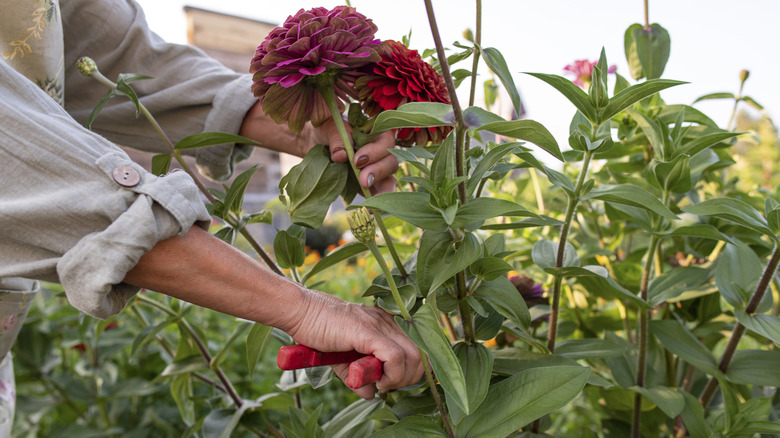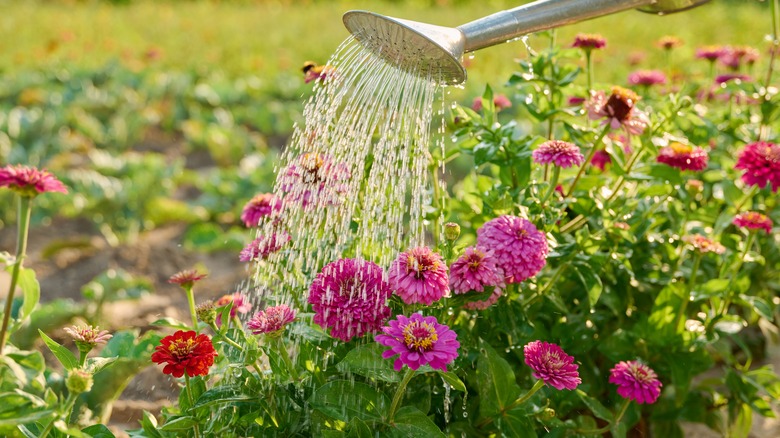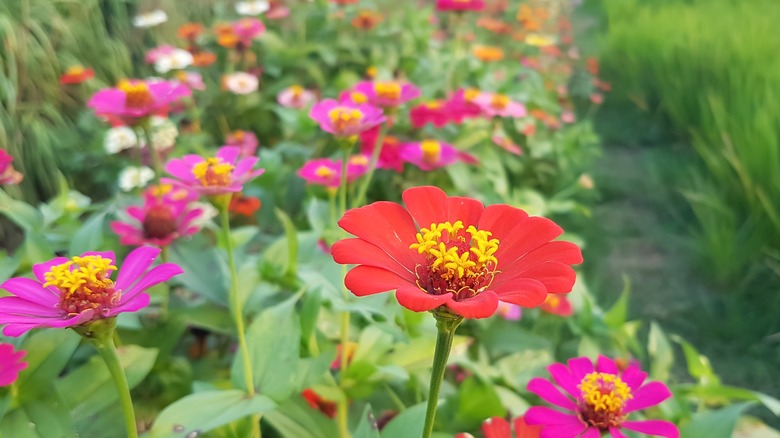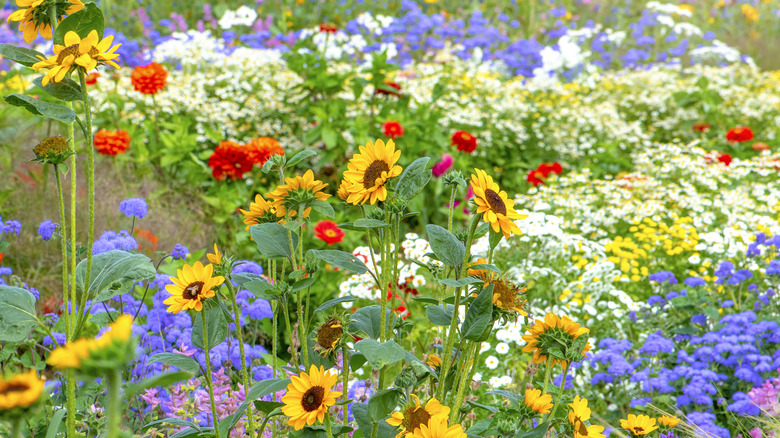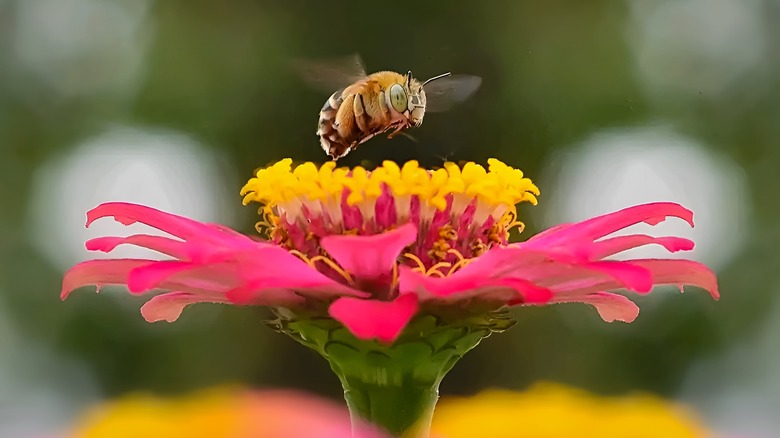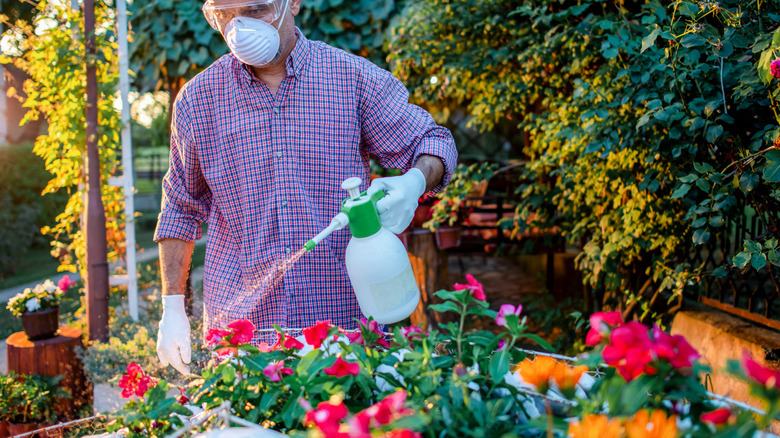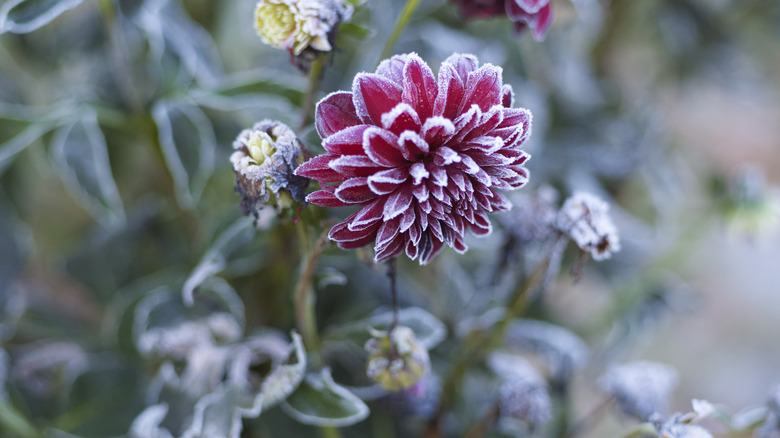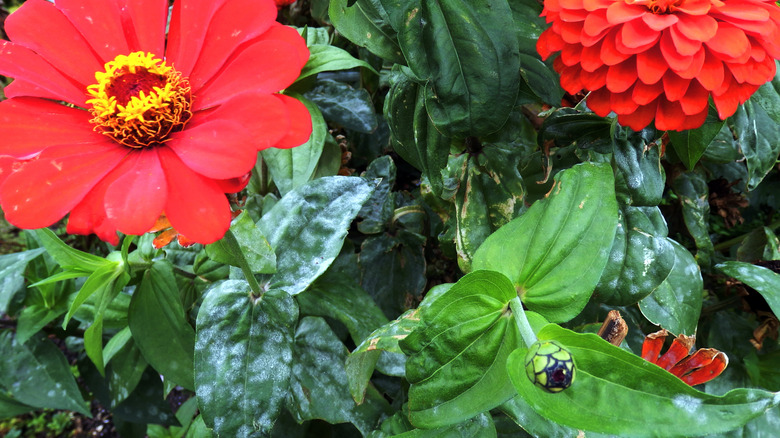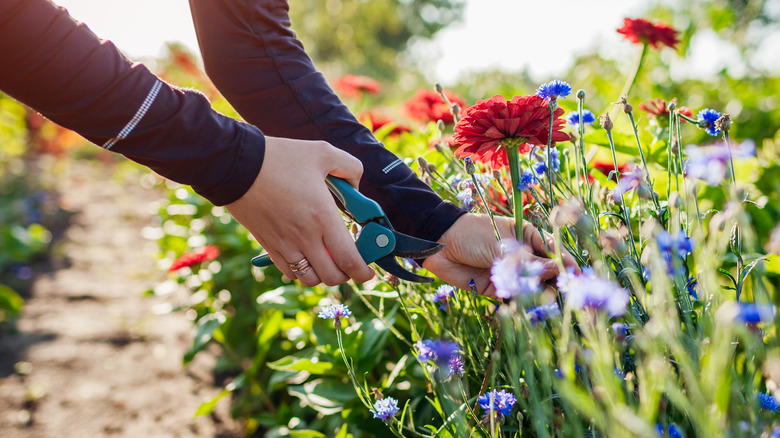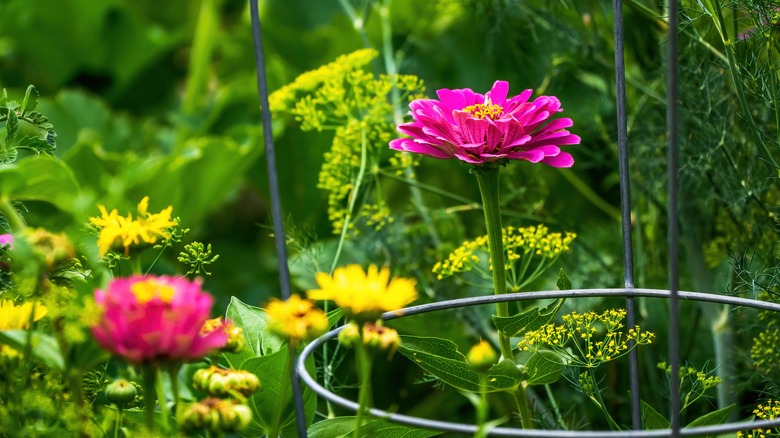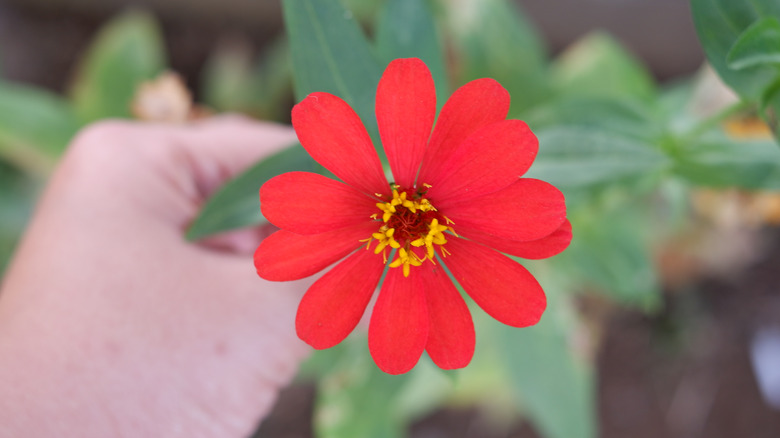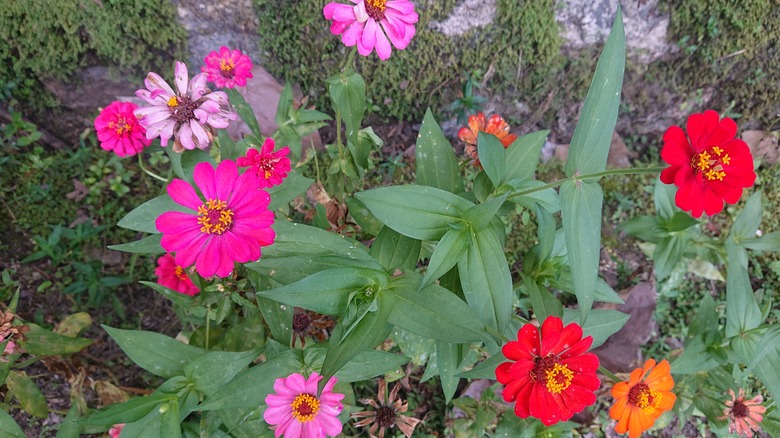11 Mistakes To Avoid When Growing Zinnias In The Garden
We may receive a commission on purchases made from links.
Originally from Mexico and Central America, zinnias are popular annual additions to gardens thanks to their overall hardiness as low-maintenance flowers. In fact, they're so resilient and adaptable that they've been grown on the International Space Station! They're one of the incredible floral species that can give multiple bloom types: single, double, or even semi-double. Zinnias are also renowned for pushing out blooms right through the growing season into autumn, meaning you'll get abundant floral bang for your buck. Thanks to this ability to put out multiple blooms throughout the year, zinnias are a showy favorite that's not only rewarding to grow, but also very forgiving to new or neglectful gardeners.
However, despite their ability to go with the flow, there's a limit to their tolerance for improper care. Luckily, most of the common mistakes gardeners make with zinnias are easily fixable, as long as you understand what they need and why. We've rounded up a few key mistakes that are easy to make when growing zinnias, including signs that something is wrong and tips for what you can do to fix issues before it's too late.
Overwatering your zinnia plants
Have your zinnias begun to look a little droopy with blooms wilting or falling off completely? Or maybe they're not growing as tall as you had hoped? Have you noticed a few white patches on the leaves or a rotting smell? Unfortunately, those are all potential signs that you've overwatered these ornamentals.
Zinnias are a little finicky when it comes to their water routines. They require regular watering but aren't able to handle being overwatered continually and would prefer you'd let things dry out a little before giving them another drink. But don't fret as this is fixable! First, use sterilized shears and cut off any dead or rotting parts of the plant. The next step depends on if your zinnia is in a pot or in the ground. For potted zinnias, repot them with fresh, dry soil and only rewater when the first 1-2 inches of topsoil are dry. For in-ground zinnias, cut back on their water routine and facilitate more drainage, if possible. If not, you may want to move them to a drier garden bed or just wait and see how they respond to more infrequent watering. Zinnias are hardy and may bounce back once they get rid of the excess water so don't give up on them yet.
Trying to grow zinnias in the shade
If your mature zinnias are slow to bloom and are looking a little limp, that could be a sign that they're not getting enough sun. Since they're native to areas near the equator, zinnias are used to getting lots and lots of sunlight. Ideally, they'd really be happiest with at least six hours of sunshine right on their buds and leaves. If they're not able to get enough light, they'll have trouble photosynthesizing and getting the energy they need to flower.
The easiest way to resolve this is to move your zinnias to a spot that gets bright, direct light. Since they're adaptable, they'll do okay in most landscapes just as long as they get their sun. If your garden space is a little cramped, though, don't worry. Zinnias can thrive as container plants so just scoop them out of the garden and put them in a pot. Then place them somewhere that gets good morning sun, like in front of a south-facing wall or directly on your own patio or deck.
Intermixing zinnias with finicky flowers
Have your zinnias begun to display white, powdery spots on their leaves? Or maybe you've noticed gray, fuzzy growths on flowers that have turned brown. Are there reddish-brown spots with gray centers that seem to get bigger every time you look? If any of these things are happening, the problem is probably due to being planted near disease- or pest-prone companions.
Zinnias may be able to handle a lot of adversity, but they can only do so much if they spend most of their time fighting pests or diseases that have hitched a ride on neighboring plants. They're particularly susceptible to powdery mildew, blight, and beetle infestations, and so should be kept away from flowers that get hit with these easily, like asters, roses, and geraniums. Your best bet to correct this is by either moving the zinnia or the sick plants to another location. You can then take the appropriate steps to care for your zinnia and get its health back on track, such as spraying with (preferably pollinator-safe) applications of copper-based fungicides or sulfur for powdery mildew infestations.
Growing zinnias if you're allergic to bees
This one isn't a mistake that has signs to it, exactly. Rather, it's a mistake people make when not thinking about the lifecycle of flowers. Flowers produce sugary nectars which attract hungry insects, known as pollinators. The pollinators land on the flower to collect the nectar and get covered in pollen grains. They then move on to the next flower, and voilà, pollination (aka plant reproduction) has happened.
One thing you need to know about zinnias is that they're excellent at attracting pollinators and are used as a nectar source by many insects. That's a great little fun fact if you love spotting butterflies, but not so much if you or a loved one is allergic to bee stings. If that's the case and you'd prefer to get rid of bees (or at least keep them to a minimum), you may want to reconsider the garden you're building and its location relative to the allergy-prone person. You can either move your zinnias to a different location or opt instead for flowers that have less easily available nectar, like impatiens, marigolds, begonias, roses, geraniums, and chrysanthemums.
Spraying zinnias with insecticide
So let's say you've cleared the bee sting allergy issue with your household and are good to go. Plus, you've kept disease-prone flowers away from the zinnias. However, you've started to feel a little uncomfortable about not giving them the best head start possible and think a quick spray of insecticide once in a while would be good. Well, we've got bad news. Since it's listed in this article, you probably realize that using an insecticide on your zinnias would be a big mistake.
But why stay away from insecticide spray? It goes back to the fact that zinnias are excellent pollen and nectar sources that attract bees, butterflies, and other pollinators. Unfortunately, broad-spectrum insecticides don't discriminate and can hurt already fragile bee and butterfly populations, so there are just too many downsides to using systemic pest control insecticides in your yard. If you want to give your zinnias a pollinator-safe pest treatment, opt for insecticidal soap instead. You can make your own DIY pest control spray with kitchen ingredients (including soap), or purchase something like the Fertilome Natural Guard insecticide soap (available on Amazon for $24.99)
Planting zinnias too early in frigid USDA zones
How early is too early to plant your zinnias? In some areas that have warmer winters, they can easily be planted in soil after the last frost of the season. However, there are a number of mitigating factors that can affect your zinnias' ability to make it through early spring. Things like soil condition, night temperatures, rain, and even proximity to large bodies of water can all push the ideal planting date further into the year. If your zinnias are super slow to grow, seem stunted, or sport signs of frost damage like blackening leaves, then it's likely they just couldn't handle how cold your garden is at that time of year.
Zinnias love arid, hot climates so they're not capable of handling the cold temperatures some USDA zones have during the early spring months. Your best bet is to wait until temperatures warm up a bit before planting. To get an early kickoff on the growing season, you can also start seeds indoors up to six weeks before planting them out. If you've already planted your zinnias, though, cut off the black or dead parts and add a plastic mulch around the base of the plant. The mulch will help raise the soil's temperature during the day and trap heat at night which might help bring your zinnia back.
Planting zinnias too close together
Have you ever seen those gorgeous gardens that look like they're ready to explode with flowers of every kind? While that might be something Insta-worthy, it can be a big problem for zinnias. If your flowers start to look like they've got a white, powdery substance on their leaves, then it's a sign they've contracted powdery mildew from a neighbor when they should've been given a little space. Highly pernicious, powdery mildew is the most prevalent disease these show-stopping annuals contract, and it can cover entire areas of the leaves, preventing the plant from being able to produce chlorophyll and keep its leaves and flowers healthy.
Spacing out zinnias allows for air to circulate around the flowers, making the environment around the leaves less conducive to fungal infections and rendering it more difficult for diseases or pests to jump from one plant to another. Since zinnias are susceptible to fungal infections and bugs that are hard to kill, it's best to give them some room, about 8-24 inches depending on the cultivar, with bushy varieties requiring the most room to spread out. If you think your zinnias are too closely spaced together, you can either dig them up and move them to a new spot, or put them into containers instead. Zinnias make excellent container plants and having them in pots will make it easier to ensure they have enough room as they grow, especially if it's your first time planting them.
Not pruning your zinnias regularly
Have your zinnias begun to lose their color? If so, it could be because you're letting them grow wild without culling their blooms. You might think it's best to let your zinnias grow and die back as they like, but this mistake can cause your plants to lose blossoms much faster than if you gave them a little attention. Luckily, it's an easy fix that will make them look their best with full, lush blooms.
Zinnias have long-lasting flowers, but their vibrancy can fade over time. To encourage blossom production, the Royal Horticultural Society recommends snipping off any branches that have faded flowers. Doing this will allow the plant to grow a new branch with a fresh, vibrant bloom. Plus, you can grow zinnia flowers from cuttings, so if you have to snip off a sizable stem, you can always propagate it into new, beautiful plants.
Not giving zinnias any support
Did you know there are zinnia cultivars that can grow as high as 3 feet tall? That's a lot of length of stem that needs to carry those big, heavy flowers! If you've begun to notice your zinnias are bending — or even breaking — their stems, then it's time to give them a helping hand by adding a little support.
Wood trellises or metal stakes can help keep your zinnia stems upright, or you could DIY your own trellis with an affordable garden hose hack and a few garden tools you've probably got lying around. However, if adding support isn't an option, there's still hope. Take your sterilized cutting shears and prune the plant down so that it's bushier and more compact, which will encourage the plant to "clump" rather than grow tall. This method works best with younger zinnias but is worth a shot to help save your mature plant from snapping its stems before you're able to enjoy the blooms.
Forgetting to give your zinnias a pinch
You've heard that zinnias can grow multiple blossoms on the same stem, but yours always looks sad and lonely with its single bloom. Why can't your plant get those overflowing clumps of flowers? Well, it could be that you've got a cultivar that only offers single flower forms, like some of the "Profusion" series zinnias. Or you simply haven't been giving your plants a little pinch.
Before you head out to do a any chopping, it's important to understand that pinching flowers is different from deadheading. "Pinching" means taking off the growing tip of a plant before or while its flowers are in bloom while "deadheading" means snipping off flowers that have bloomed and have already died. Deadheading helps clean up a plant's appearance and encourage more flowers, while pinching lets you play with the plant's growth habits. Yes, you'll probably have to sacrifice the first few flowers from your zinnia, but pinching off the top will encourage your plant to branch out, creating new stems and flowers.
Planting zinnias in heavy soil
If your zinnias are getting more than their fair share of fungal diseases, haven't grown much, or seem like they're constantly sitting in a pool of water, then it could be that they're living in the wrong type of soil. It sounds so simple, but soil quality is a complex issue that involves dealing with compaction, pH levels, and nutrient amounts. Depending on the severity of the issue, this could be an easy fix or one that requires you to only use certain types of plants for your garden.
So what sort of soil does a zinnia need to thrive? Well, the Missouri Botanical Garden recommends a growing medium that they refer to as "humusy," and not, as we first read, "hummus-y." Humus-rich soil has organic materials like dead leaves and roots that have begun breaking down into carbon, which improves the soil's structure and ability to hold nutrients and water. Humus also has high nitrogen levels which helps promote plant growth. The soil blend should also be well-draining so that your zinnia's roots get just the right amount of water they need. If you're concerned, there are a few simple DIY tests for checking the health of your soil or you can move the zinnia into a pot with a well-draining blend.
